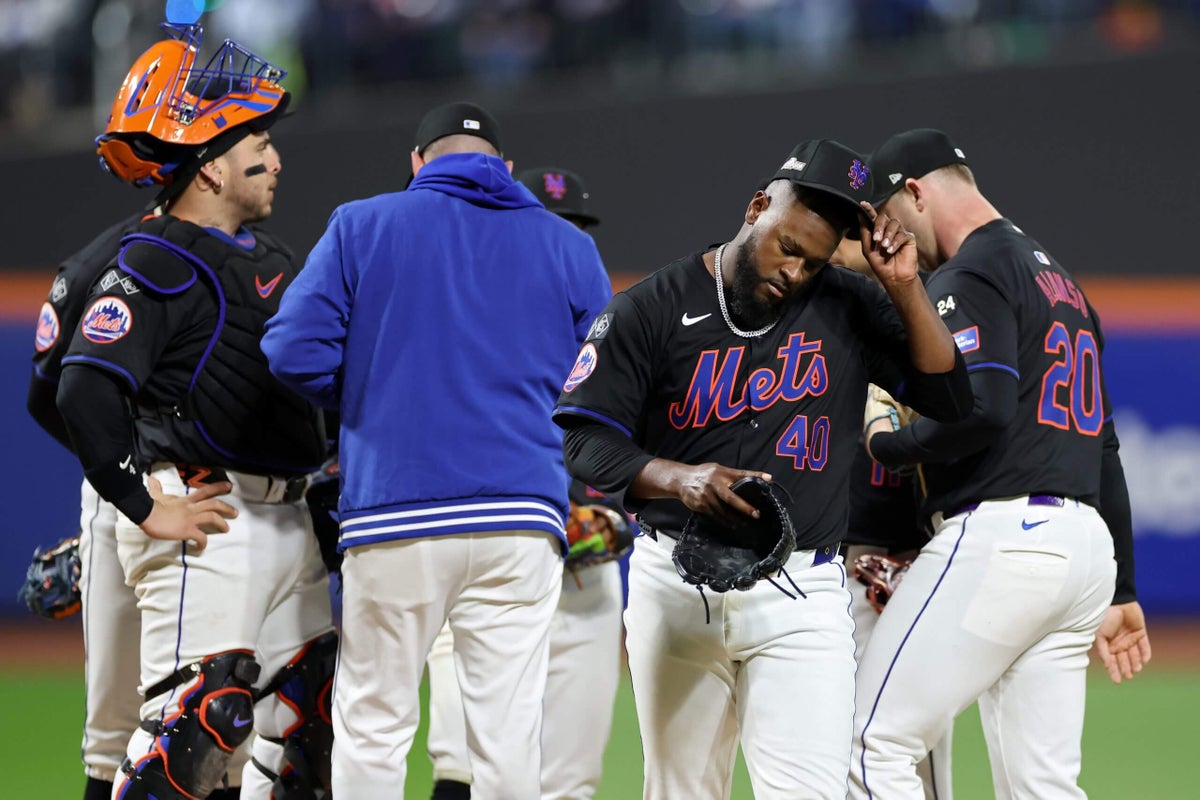NEW YORK — By the time Shohei Ohtani’s moonshot of a home run finally landed, over the foul pole in right field and just barely in fair territory, the fans at Citi Field were already streaming toward the exits.
Ohtani’s three-run homer in the eighth inning was the nail in the coffin of another rout in this National League Championship Series. The NLCS continued to be a back-and-forth of one-sided affairs, the Los Angeles Dodgers and New York Mets trading early haymakers. For the second time in three games, it was the Dodgers pummeling the Mets’ pitching while shutting out New York’s bats, this time in an 8-0 romp in Game 3.
Los Angeles leads the series 2-1, and Jose Quintana will face Yoshinobu Yamamoto in Game 4 on Thursday night.
There have been 27 innings in this series. After only one of them — Wednesday’s first inning — has the score been tied. One side has led by multiple runs after 25 of those innings, and the lead has been four or more after 15 of those 27 frames.
For the Mets, Wednesday night was an ugly replay of Sunday’s Game 1. Like in the NLCS opener, New York’s defense cost it runs early, and its offense bypassed whatever opportunities it was able to generate. The Mets have scored seven runs in three games; the majority of which came home on one Mark Vientos swing.
For the series, the Mets are hitting .179 with a .292 on-base percentage and .555 OPS. Those numbers would be a slump for Rey Ordoñez.
“We just haven’t been able to come up with a big hit,” manager Carlos Mendoza said. “As long as we continue to create traffic, somebody’s going to come up and get that big one for us.”
New York’s biggest chance came in the bottom of the second when it loaded the bases with one out against Walker Buehler. Buehler, who didn’t strike out a single hitter in his five-inning NLDS start in San Diego, got out of the jam with punchouts of Francisco Alvarez and Francisco Lindor — two of the six Ks he had on the night.
Alvarez’s slump deepened with three called strikeouts Wednesday. He has five singles in 35 postseason at-bats. Worse yet, he keeps coming to the plate in significant situations for the Mets’ offense. In the last two games, he’s batted with the bases loaded twice and two men on twice. On two of those occasions, there was a runner on third with fewer than two outs; both times, Alvarez couldn’t get him home.

Francisco Alvarez’s struggles have come at an inopportune time. (Sarah Stier / Getty Images)
That lack of productivity at the bottom of the order contrasts sharply with what the Dodgers have received from the latter part of their lineup. Los Angeles is rightfully known for its fearsome top three of MVPs: Ohtani, Mookie Betts and Freddie Freeman. To this point, the Mets have worked that group carefully and, for the most part, effectively through three games. The trio has drawn eight walks but didn’t have a home run until Ohtani’s long ball in the eighth inning Wednesday.
But the crucial second point of working that group carefully is dominating the bottom part of the order. That’s what the Mets did in their NLDS triumph over the Phillies, when they suffocated the bottom half of Philadelphia’s order.
It’s been an entirely different story in this series: Los Angeles’ seventh through ninth hitters have carried its offense. In Game 1, that bottom third of the order scored five of the Dodgers’ nine runs. It accounted for four more runs Wednesday night, with two coming in on Kiké Hernández’s back-breaking two-run homer off Reed Garrett in the sixth.
For the series, Los Angeles’ bottom third owns a .333 average and .950 OPS.
Mets pitchers v. bottom third of order
|
Team
|
PA
|
HR
|
R
|
RBI
|
AVG
|
OBP
|
SLG
|
OPS
|
|---|---|---|---|---|---|---|---|---|
|
47 |
0 |
2 |
1 |
0.116 |
0.191 |
0.140 |
0.331 |
|
|
38 |
2 |
10 |
6 |
0.333 |
0.417 |
0.533 |
0.950 |
(L.A.’s top six in the order are batting a combined .203 with a .665 OPS.)
“They’re here for a reason, they’re on a good team for a reason,” Garrett said. “The biggest thing is going and attacking and trusting your stuff.”
There’s a rub there, too. The Dodgers’ lineup, in general, posed one particular challenge for the Mets’ pitching staff: Los Angeles does not chase, and New York issues a lot of walks. The Mets had gotten that problem under control late in the season and through the first two rounds of the postseason. They’d walked 20 batters through the seven games of the Wild Card Series and NLDS.
New York has walked 22 in the first three games of this series, issuing at least seven free passes in each game.
“That’s what makes them such a good team offensively,” Mendoza said. “They control the strike zone.”
As has become custom, the Mets expressed confidence in their ability to rebound.
“This is nothing new,” said Luis Severino, whose inability to come up with a pair of comebackers in the second inning helped lead to a pair of runs. “We just need to come back tomorrow.”
He’s right: The Mets have been through this particular turnaround very recently.
“We got beat 9-0 in the first game and came back and won Game 2,” said Garrett. “I don’t see why we can’t do that tomorrow.”
(Photo of Luis Severino exiting the game: Sarah Stier / Getty Images)

